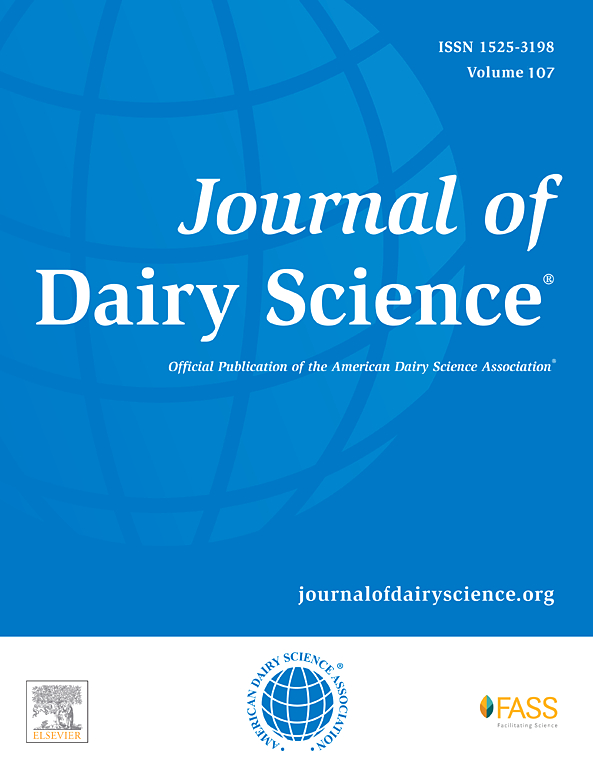通过本地和全球混合方法对 INRA 2018 年反刍动物饲喂系统进行敏感性分析:比较日粮输入变量对奶牛多反应预测的贡献。
IF 4.4
1区 农林科学
Q1 AGRICULTURE, DAIRY & ANIMAL SCIENCE
引用次数: 0
摘要
我们对应用于奶牛的 INRA 2018 反刍动物饲喂系统进行了敏感性分析(SA)。考虑到输入变量之间可能存在的相互作用,我们评估了哪些日粮输入变量对每个输出变量的变化贡献最大。考虑到潜在的相互作用和非单调性,我们采用了定量分析(一次性分析,OAT;即局部SA)和基于方差的SA相对比较分析(全局SA,GSA)。选择了 5 个可能有影响的日粮输入变量:CP、总能(GE)、OM 表观消化率(OMd)、假设通过率为 6%/h 的氮的有效降解率(ED6_N)和氮的真实肠道消化率。分析了 5 种选定的动物反应(输出变量)对输入变量的敏感性:DMI、乳蛋白产量 (MPY)、甲烷能量 (ECH4)、氮利用效率 (NUE) 以及尿和总氮排泄量之比 (UN/TN)。为了满足多胎奶牛在泌乳期第 14 周 95% 的潜在产奶量(37.5 千克/天),我们配制了六种奶牛日粮,反映了实践中常用日粮的多样性。对于每种日粮,围绕 INRA 2018 饲料表数值(参考点)随机抽取 5 个输入变量,并使用配给软件 INRAtion®V5 计算围绕该参考情况的动物反应。在 OAT 中,通过计算参考点的归一化正切值来量化动物反应的敏感性;在 GSA 中,通过计算 Sobol 指数来确定各输入变量及其交互作用的相对影响。在两种 SA 方法中,5 个关键输入变量对 INRA 饲养系统预测的 5 种主要动物反应的影响是一致的。在 6 种日粮中,GE 和 OMd 是导致 DMI、MPY、ECH4 和 NUE 变化的主要因素。粗蛋白是造成 UN/TN 变化的主要因素,也是造成 NUE 变化的另一个主要因素。当考虑OAT时,产出的敏感性因日粮而异,尤其是对DMI和MPY的敏感性。与其他日粮相比,以青草为基础的日粮(GH 日粮)的 DMI 对输入变量的敏感性较低,而 MPY 对输入变量的敏感性较高。在考虑GSA时,DMI和MPY的输入变量之间的交互作用也很明显;DMI与GH日粮的交互作用较高,MPY与新鲜黑麦草和青贮饲料日粮的交互作用较高。另一方面,就 MPY 而言,非 GH 日粮对投入变量变化的敏感性较低,投入之间的交互作用高于 GH 日粮。在这两种情况下,相互作用主要与能量相关的投入(即 OMd 和 GE)有关。我们的结果支持以下假设:与 DMI 不同,MPY 在高 PDI/UFL 比值(即代谢蛋白与 NEL 之间,如 GH 日粮 >117 g PDI/UFL)时比低 PDI/UFL 比值时对能量相关因素的反应更灵敏。因此,混合使用SA方法有助于解释该系统,并促进对其进行更精确的评估,尤其是GSA,它适合非单调模型,如表征整合了多种营养和动物因素的复杂饲喂系统的模型。本文章由计算机程序翻译,如有差异,请以英文原文为准。
Sensitivity analysis of the INRA 2018 feeding system for ruminants by hybrid local and global approaches: Comparing the contribution of dietary input variables to multiple response prediction in dairy cattle
We conducted sensitivity analysis (SA) of the French National Institute of Agricultural Research (Institut national de la recherche agronomique; INRA) 2018 feeding system for ruminants applied to dairy cows. We evaluated which dietary input variables contribute most to changes in each output variable, considering the potential interactions presence among input variables. We applied a quantitative analysis (one-at-a-time analysis, OAT; i.e., local SA) and a relative comparative analysis (global SA; GSA) through variance-based SA considering potential interactions and nonmonotonicity. The 5 likely influential dietary input variables were selected: CP, gross energy (GE), OM apparent digestibility (OMd), effective degradability of nitrogen assuming a passage rate of 6%/h, and true intestinal digestibility of nitrogen. The sensitivity of 5 selected animal responses (output variables) to input variables was analyzed: DMI, milk protein yield (MPY), energy in methane (ECH4), nitrogen utilization efficiency (NUE), and the ratio between urine and total N excretion (UN/TN). Six diets for dairy cattle, reflecting the diversity of diets commonly used in practice, were formulated to meet 95% of the potential milk production (37.5 kg/d) of a multiparous dairy cow at wk 14 of lactation. For each diet, the 5 input variables were randomly sampled around the INRA 2018 feed table values (reference point), and the animal responses around this reference situation were calculated using the rationing software INRAtion V5. In OAT, the sensitivity of animal responses was quantified by calculating the normalized tangent value at the reference point, and in GSA, the Sobol indices were calculated for relative influence of each input and their interaction. The influence of the 5 key input variables on the 5 main animal responses predicted from the INRA feeding system was consistent across both SA approaches. With the 6 diets, GE and OMd appeared as the main contributors to changes in DMI, MPY, ECH4, and NUE. Crude protein was the main contributor to changes in UN/TN and another major contributor to changes in NUE. When considering OAT, the sensitivity of outputs showed differences depending on diet, more particularly for DMI and MPY. With grass hay–based diets (GH), DMI was less sensitive and MPY was more sensitive to variations in input variables than other diets. When considering GSA, interactions between input variables were also noticeable for DMI and MPY; the interactions were high with the GH diets for DMI, and with fresh ryegrass and grass silage diets for MPY. On the other hand, for MPY, the non-GH diets were less sensitive to variations in input variables, and the interaction between inputs was higher than with GH diets. Our results support the hypothesis that MPY, unlike DMI, is more responsive to energy-related factors at a high true intestinal digestible protein (PDI) to net energy for lactation (UFL) ratio (e.g., GH diets >117 g PDI/UFL), than at a lower PDI/UFL ratio. Hence, hybridizing the SA methods can help to interpret the system and facilitate a more precise evaluation thereof, especially GSA, which is amenable to nonmonotonic models such as those characterizing complex feeding systems integrating multiple nutritional and animal factors.
求助全文
通过发布文献求助,成功后即可免费获取论文全文。
去求助
来源期刊

Journal of Dairy Science
农林科学-奶制品与动物科学
CiteScore
7.90
自引率
17.10%
发文量
784
审稿时长
4.2 months
期刊介绍:
The official journal of the American Dairy Science Association®, Journal of Dairy Science® (JDS) is the leading peer-reviewed general dairy research journal in the world. JDS readers represent education, industry, and government agencies in more than 70 countries with interests in biochemistry, breeding, economics, engineering, environment, food science, genetics, microbiology, nutrition, pathology, physiology, processing, public health, quality assurance, and sanitation.
 求助内容:
求助内容: 应助结果提醒方式:
应助结果提醒方式:


